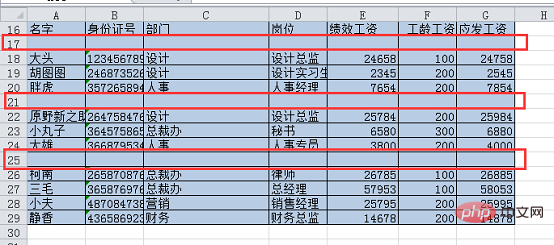In the previous article "Practical Excel Tips Sharing: Quick Data Summing and Adding Styles for Subtotal Rows", we learned how to quickly sum data and add styles for multiple cross-row subtotal rows . Today we are going to talk about Excel’s positioning function, which is not easy to use! Want to select all formulas? Or do you want to select all empty rows? All done in 3 seconds, let’s learn together!

Is there anyone who hasn’t used Excel’s positioning function? I have never used it before
Okay, today we will introduce the wonderful use of the positioning function.
1. Positioning formula
As shown in the figure below, after we finish the salary table, we want to select the cells with formulas and put Formula results are fixed.

Select the entire table area.
Press the positioning shortcut key ctrl G, the following dialog box will pop up, click on the positioning conditions.
Click "Formula" in the new dialog box that pops up. The options under the formula represent formulas containing only numbers, formulas containing only text, etc. The default is all Select it and click the OK button after setting.
#You can see at this point that all cells with formulas in the table are selected.
Then we press the copy shortcut key "ctrl C", then select "Value" from the "Paste" drop-down menu under the "Home" tab of the unit price.
#At this point we can see that the cells with formulas have fixed results. Click any cell and you will see only numbers and no formulas in the edit bar.
In fact, in addition to selecting all cells with formulas, in the same way, we can also select all objects in excel (shapes, text boxes, charts, etc.), only You just need to check "Object" in the positioning dialog box. You can go down and try it yourself.
2. Locate blank rows
As you can see, there are several rows in my table below If the rows are empty, when the data is relatively large, deleting them one by one is a waste of time.

Select the entire table area.
Press the positioning shortcut key "ctrl G", as before, click "Location Conditions" in the pop-up dialog box, and select "Empty" in the new dialog box value".
You can see at this point that all spaces are selected and highlighted in blue.
Right-click on the selected empty cell and select "Delete" in the drop-down list.
Click "Entire Row" in the pop-up dialog box, and click OK to complete.
At this point you will find that all blank lines have been deleted.
The above uses positioning to delete empty lines. Let’s expand it and use filtering to delete empty lines.
Select the entire table area and click the "Data"-"Filter" button.
At this point, you will see that a drop-down option has been added to the title of the first row of the table.
Click the drop-down button in the name column, deselect all, check "Blank", and click OK.
At this point you can see that only blank areas are displayed in the table.
Select the filtered blank area.

Right-click and select "Delete Row" from the drop-down menu.
Click OK in the pop-up dialog box.
At this point you can see that the blank lines are deleted and only the title row is displayed.

Click the "Name" drop-down menu, check Select All, and click OK after setting.
You can see the final result at this time.
If you want to cancel the filter drop-down menu, just click the "Filter" button under the "Data" tab again.

3. Locate visible cells
As shown in the figure below, we filtered the table (The screening method is the same as before, so I won’t go into details here.) Only the design department was retained.

Friends who use the 2007 version can give it a try. At this time, if you directly copy and paste the entire table area above, you will find that the hidden cells appear again after copying and pasting. It is displayed (this is just a BUG in the 2007 version). If we only want to copy visible cells, we need to position them first.
Select the table area.
Press the positioning shortcut key "ctrl G", click "Location Conditions" in the dialog box, click "Visible Cells" in the new dialog box, and set Click OK when done.
At this time you can see that all visible cells are selected.

Directly press the copy shortcut key ctrl c, then click on a blank cell and press ctrl v. You can see that only the visible cells are copied.

Similarly, after completing the salary statistics table, the wages were paid, and the sales department performed well. The boss suddenly said that the wages payable to the sales department staff would be directly increased by 200. As a bonus, we can also filter out the sales department personnel first, locate the visible cells, and then do the "Copy" - "Paste Special" - "Add" operation. No matter what version of this operation you can try, if you don’t locate the visible cells first, the wages of all employees will be increased by 200. If you don’t believe it, you can try it!
For those who don’t know how to paste selectively, you can take a look at the previous tutorial. The link is here: //m.sbmmt.com/topic/excel/491640.html
Related learning recommendations:excel tutorial
The above is the detailed content of Practical Excel skills sharing: It turns out that the 'positioning function' is so useful!. For more information, please follow other related articles on the PHP Chinese website!
 Compare the similarities and differences between two columns of data in excel
Compare the similarities and differences between two columns of data in excel excel duplicate item filter color
excel duplicate item filter color How to copy an Excel table to make it the same size as the original
How to copy an Excel table to make it the same size as the original Excel table slash divided into two
Excel table slash divided into two Excel diagonal header is divided into two
Excel diagonal header is divided into two Absolute reference input method
Absolute reference input method java export excel
java export excel Excel input value is illegal
Excel input value is illegal



